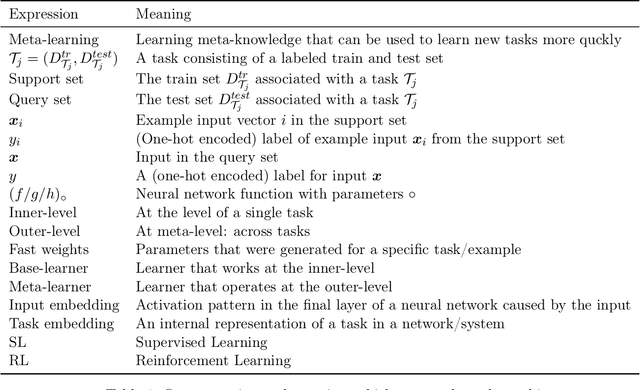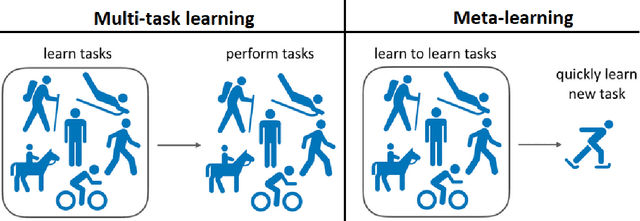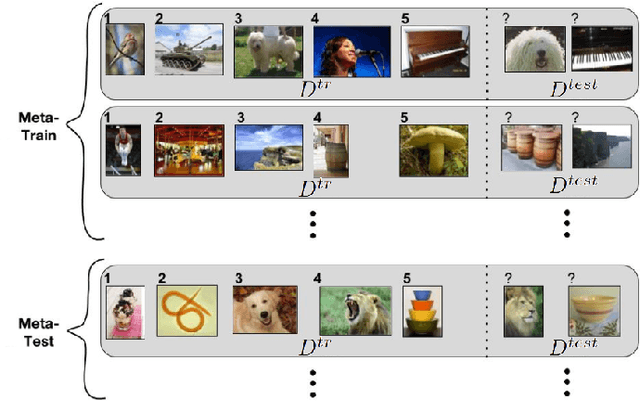Mike Huisman
LIACS
Are LSTMs Good Few-Shot Learners?
Oct 22, 2023Abstract:Deep learning requires large amounts of data to learn new tasks well, limiting its applicability to domains where such data is available. Meta-learning overcomes this limitation by learning how to learn. In 2001, Hochreiter et al. showed that an LSTM trained with backpropagation across different tasks is capable of meta-learning. Despite promising results of this approach on small problems, and more recently, also on reinforcement learning problems, the approach has received little attention in the supervised few-shot learning setting. We revisit this approach and test it on modern few-shot learning benchmarks. We find that LSTM, surprisingly, outperform the popular meta-learning technique MAML on a simple few-shot sine wave regression benchmark, but that LSTM, expectedly, fall short on more complex few-shot image classification benchmarks. We identify two potential causes and propose a new method called Outer Product LSTM (OP-LSTM) that resolves these issues and displays substantial performance gains over the plain LSTM. Compared to popular meta-learning baselines, OP-LSTM yields competitive performance on within-domain few-shot image classification, and performs better in cross-domain settings by 0.5% to 1.9% in accuracy score. While these results alone do not set a new state-of-the-art, the advances of OP-LSTM are orthogonal to other advances in the field of meta-learning, yield new insights in how LSTM work in image classification, allowing for a whole range of new research directions. For reproducibility purposes, we publish all our research code publicly.
Subspace Adaptation Prior for Few-Shot Learning
Oct 13, 2023Abstract:Gradient-based meta-learning techniques aim to distill useful prior knowledge from a set of training tasks such that new tasks can be learned more efficiently with gradient descent. While these methods have achieved successes in various scenarios, they commonly adapt all parameters of trainable layers when learning new tasks. This neglects potentially more efficient learning strategies for a given task distribution and may be susceptible to overfitting, especially in few-shot learning where tasks must be learned from a limited number of examples. To address these issues, we propose Subspace Adaptation Prior (SAP), a novel gradient-based meta-learning algorithm that jointly learns good initialization parameters (prior knowledge) and layer-wise parameter subspaces in the form of operation subsets that should be adaptable. In this way, SAP can learn which operation subsets to adjust with gradient descent based on the underlying task distribution, simultaneously decreasing the risk of overfitting when learning new tasks. We demonstrate that this ability is helpful as SAP yields superior or competitive performance in few-shot image classification settings (gains between 0.1% and 3.9% in accuracy). Analysis of the learned subspaces demonstrates that low-dimensional operations often yield high activation strengths, indicating that they may be important for achieving good few-shot learning performance. For reproducibility purposes, we publish all our research code publicly.
Understanding Transfer Learning and Gradient-Based Meta-Learning Techniques
Oct 09, 2023



Abstract:Deep neural networks can yield good performance on various tasks but often require large amounts of data to train them. Meta-learning received considerable attention as one approach to improve the generalization of these networks from a limited amount of data. Whilst meta-learning techniques have been observed to be successful at this in various scenarios, recent results suggest that when evaluated on tasks from a different data distribution than the one used for training, a baseline that simply finetunes a pre-trained network may be more effective than more complicated meta-learning techniques such as MAML, which is one of the most popular meta-learning techniques. This is surprising as the learning behaviour of MAML mimics that of finetuning: both rely on re-using learned features. We investigate the observed performance differences between finetuning, MAML, and another meta-learning technique called Reptile, and show that MAML and Reptile specialize for fast adaptation in low-data regimes of similar data distribution as the one used for training. Our findings show that both the output layer and the noisy training conditions induced by data scarcity play important roles in facilitating this specialization for MAML. Lastly, we show that the pre-trained features as obtained by the finetuning baseline are more diverse and discriminative than those learned by MAML and Reptile. Due to this lack of diversity and distribution specialization, MAML and Reptile may fail to generalize to out-of-distribution tasks whereas finetuning can fall back on the diversity of the learned features.
Meta-Album: Multi-domain Meta-Dataset for Few-Shot Image Classification
Feb 16, 2023Abstract:We introduce Meta-Album, an image classification meta-dataset designed to facilitate few-shot learning, transfer learning, meta-learning, among other tasks. It includes 40 open datasets, each having at least 20 classes with 40 examples per class, with verified licences. They stem from diverse domains, such as ecology (fauna and flora), manufacturing (textures, vehicles), human actions, and optical character recognition, featuring various image scales (microscopic, human scales, remote sensing). All datasets are preprocessed, annotated, and formatted uniformly, and come in 3 versions (Micro $\subset$ Mini $\subset$ Extended) to match users' computational resources. We showcase the utility of the first 30 datasets on few-shot learning problems. The other 10 will be released shortly after. Meta-Album is already more diverse and larger (in number of datasets) than similar efforts, and we are committed to keep enlarging it via a series of competitions. As competitions terminate, their test data are released, thus creating a rolling benchmark, available through OpenML.org. Our website https://meta-album.github.io/ contains the source code of challenge winning methods, baseline methods, data loaders, and instructions for contributing either new datasets or algorithms to our expandable meta-dataset.
Stateless Neural Meta-Learning using Second-Order Gradients
Apr 21, 2021



Abstract:Deep learning typically requires large data sets and much compute power for each new problem that is learned. Meta-learning can be used to learn a good prior that facilitates quick learning, thereby relaxing these requirements so that new tasks can be learned quicker; two popular approaches are MAML and the meta-learner LSTM. In this work, we compare the two and formally show that the meta-learner LSTM subsumes MAML. Combining this insight with recent empirical findings, we construct a new algorithm (dubbed TURTLE) which is simpler than the meta-learner LSTM yet more expressive than MAML. TURTLE outperforms both techniques at few-shot sine wave regression and image classification on miniImageNet and CUB without any additional hyperparameter tuning, at a computational cost that is comparable with second-order MAML. The key to TURTLE's success lies in the use of second-order gradients, which also significantly increases the performance of the meta-learner LSTM by 1-6% accuracy.
A Survey of Deep Meta-Learning
Oct 07, 2020



Abstract:Deep neural networks can achieve great successes when presented with large data sets and sufficient computational resources. However, their ability to learn new concepts quickly is quite limited. Meta-learning is one approach to address this issue, by enabling the network to learn how to learn. The exciting field of Deep Meta-Learning advances at great speed, but lacks a unified, insightful overview of current techniques. This work presents just that. After providing the reader with a theoretical foundation, we investigate and summarize key methods, which are categorized into i) metric-, ii) model-, and iii) optimization-based techniques. In addition, we identify the main open challenges, such as performance evaluations on heterogeneous benchmarks, and reduction of the computational costs of meta-learning.
 Add to Chrome
Add to Chrome Add to Firefox
Add to Firefox Add to Edge
Add to Edge